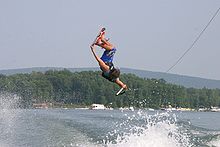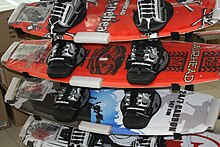Wakeboard
A wakeboard is a piece of water sports equipment in the form of a board with which the athlete can slide on the water when pulled by a boat or a lift. In contrast to the surfboard and wakeskate , it has a binding to fasten the feet. The driver stands on the board sideways to the direction of travel. It is pulled by a motorboat or a water ski lift , also called a cable. The sport is called wakeboarding or, in German, wakeboarding or waking .
The name wakeboard comes from the keel wave of the pulling motor boat ( wake ), which wakeboarders use as a jump ramp. A jump, the so-called kicker , is used for jumps in cable car operations.
In Germany alone there are now over 70 cables. This means that Germany has the highest density of water ski lifts per country in the world. The best known are in Langenfeld, Paderborn, Salzgitter and Thulba, among others.
A motorboat or jet ski usually pulls a wakeboarder at 35 to 39 km / h, the cable cars at 28 to 32 km / h. Competitions are held on both boats and cable cars.
history
Wakeboarding emerged in the 1980s as a mixture of water skiing and surfing . When the surfers were waiting for waves during a lull and boredom arose, they sometimes let themselves be pulled by a motorboat on the surfboard . This sport is now called wakesurfing, while wakeboarding is closer to water skiing. Wakeboarding has been represented at the World Games since 2005 . Nominations for the World Games are made by the national associations belonging to the IWWF.
On July 4, 2011, the International Olympic Committee (IOC) put wakeboarding as one of seven sports on the so-called “Short List” for the 2020 Olympic Games , from which any new disciplines will then be selected. Ultimately, however, wakeboarding was not taken up.
September 2016 shows a video of Valter Ošniek's wakeboarding pulled by a battery-powered multicopter drone from Aerones, Latvia.
Timetable
- 1946 Foundation of today's International Water Ski and Wakeboard Association IWWF
- 1967 The International Association IWWF is recognized by the IOC
- 1990 Founding of the World Wake Association in Florida
- 1995 Foundation of the first German wakeboard club in Berlin
- 2001 First official wakeboard world championship in Duisburg
- 2005 Wakeboarding is represented at the World Games
- 2011 Cable wakeboarding is nominated for Olympia 2020
organization
In Germany, the German Waterskiing and Wakeboarding Association (DWWV) is the leading association of all clubs involved in water skiing and wakeboarding recognized by the German Sports Association. Internationally, the International Federation for Water Skiing and Wakeboarding (IWWF) was recognized by the International Olympic Committee (IOC) in 1967. The IWWF is responsible for rules and referee training, among other things.
Wakeboard (sports equipment)
The most important features of a wakeboard include the rockers (bends), the channels (guide channels), the shape of the board and the design of the fins . Wakeboards are buoyant thanks to their foam, honeycomb or wooden core, between 111 and 151 cm long and approx. 38 to 50 cm wide.
The "rocker" describes the curve of a wakeboard when viewed from the side. So-called “3-stage rocker” wakeboards are angled upwards at the front and rear ends.
Some boards have a continuous rocker . Such wakeboards promise fast, smooth rides and good pop. Wakeboards with a continuous rocker are good for carving, especially in soft, smooth water.
In addition, the configuration and arrangement of the fins and bindings varies depending on the surfer's wishes or the type of different tricks. For example, flat fins (that don't protrude far into the water) are good for tricks on the water surface without jumping.
The boards are often set so that the driver can use them to switch , whereby the shape of the board is usually set symmetrically.
technology
In the beginning wakeboarding was called "snowboarding in summer". As with snowboarding, wakeboarding has two different positions for the rider to stand on the board. A distinction is made between "Goofy" and "Regular". When driving goofy, the right foot is placed in front in the direction of travel. When driving regularly, the whole game is turned around. The left foot is in front of the board and the right foot is behind.
The boarder reaches the height for his jumps through targeted pressure build-up and the pull of the system upwards, which catapults him into the air and gives him time for turns (rolls) and grabs . This build-up of pressure is called an "edge", a trick with a board over your head is an "invert". Various systems are equipped with artificial obstacles ( obstacles : funbox , box , kicker , rail , slider ) for tricks.
Web links
- International Waterski and Wakeboard Federation
- German Water Ski and Wakeboard Association V.
- Overview of wakeboard systems in Germany, Austria and other countries
Individual evidence
- ↑ New sports on the shortlist for the 2020 Olympics on the website of the German Olympic Sports Confederation ; Retrieved November 4, 2011
- ↑ Wakeboarding not at the 2020 Olympics
- ↑ Droneboarding - Wakeboarder towed by Aerones drone Aerones, youtube.com, uploaded September 29, 2016, accessed August 22, 2017.




